Comparing Immersive and Non-Immersive VR: Effects on Spatial Learning and Aesthetic Experience in Museum Settings
Abstract
1. Introduction
2. Materials and Methods
2.1. Participants
2.2. Measures
2.3. Procedure
3. Statistical Analysis
3.1. Results
3.1.1. H1: Influence of Different Levels of Immersion on Perceived Immersion, Pleasantness, and Intention to Repeat Similar Experiences
3.1.2. H2. HMD vs. Non-Immersive VR Experience Affects the Time Participants Require to Learn the Museum Environment
3.1.3. H3. The More the Individual Is Exposed to an Immersive Condition, the Greater the Flow Experienced, Which, in Turn, Would Negatively Affect Learning Time
4. Discussion
5. Conclusions
Author Contributions
Funding
Institutional Review Board Statement
Informed Consent Statement
Data Availability Statement
Conflicts of Interest
References
- Bekele, M.K.; Pierdicca, R.; Frontoni, E.; Malinverni, E.S.; Gain, J. A Survey of Augmented, Virtual, and Mixed Reality for Cultural Heritage. ACM J. Comput. Cult. Herit. 2018, 11, 7. [Google Scholar] [CrossRef]
- Champion, E. Virtual Heritage: A Guide; Ubiquity Press: London, UK, 2021. [Google Scholar] [CrossRef]
- Sylaiou, S.; Liarokapis, F.; Kotsakis, K.; Patias, P. Virtual Museums, a Survey and Some Issues for Consideration. J. Cult. Herit. 2010, 10, 520–528. [Google Scholar]
- Papagiannakis, G.; Schertenleib, S.; O’Kennedy, B.; Arevalo-Poizat, M.; Magnenat-Thalmann, N.; Stoddart, A.; Thalmann, D. Mixing Virtual and Real Scenes in the Site of Ancient Pompeii. Comput. Anim. Virtual Worlds 2005, 16, 11–24. [Google Scholar] [CrossRef]
- Gaitatzes, A.; Christopoulos, D.; Roussou, M. Reviving the Past: Cultural Heritage Meets Virtual Reality. In Proceedings of the International Conference on Virtual Systems and Multimedia, Berkeley, CA, USA, 25–27 October 2001; pp. 103–110. [Google Scholar]
- Rasheed, A.; Kamsin, N.; Aniza Abdullah, A. Challenges in the Online Component of Blended Learning: A Systematic Review. Comput. Educ. 2020, 144, 103701. [Google Scholar] [CrossRef]
- Li, J.; van der Spek, E.D.; Feijs, L.; Wang, F.; Hu, J. A Bibliometric Analysis of Virtual Reality and Augmented Reality in the Context of Museum Exhibitions. Appl. Sci. 2023, 13, 3018. [Google Scholar]
- Agostino, D.; Costantini, C. A Measurement Framework for Assessing the Digital Transformation of Cultural Institutions: The Italian Case. Meditari Account. Res. 2022, 30, 1168. [Google Scholar] [CrossRef]
- Samaroudi, M.; Echavarria, K.R.; Perry, L. Heritage in Lockdown: Digital Provision of Memory Institutions in the UK and US of America during the COVID-19 Pandemic. Mus. Manag. Curatorsh. 2020, 35, 337–361. [Google Scholar] [CrossRef]
- Chen, S.; Tian, Y.; Pei, S. Technological Use from the Perspective of Cultural Heritage Environment: Augmented Reality Technology and Formation Mechanism of Heritage-Responsibility Behaviors of Tourists. Sustainability 2024, 16, 8261. [Google Scholar] [CrossRef]
- Lee, H.; Jung, T.H.; Tom Dieck, M.C.; Chung, N. Experiencing Immersive Virtual Reality in Museums. Inf. Manag. 2020, 57, 103229. [Google Scholar] [CrossRef]
- Tussyadiah, I.P.; Wang, D.; Jung, T.H.; Tom Dieck, M.C. Virtual Reality, Presence, and Attitude Change: Empirical Evidence from Tourism. Tour. Manag. 2018, 66, 140–154. [Google Scholar] [CrossRef]
- Bruno, F.; Bruno, S.; De Sensi, G.; Luchi, M.L.; Mancuso, S.; Muzzupappa, M. From 3D Reconstruction to Virtual Reality: A Complete Methodology for Digital Archaeological Exhibition. J. Cult. Herit. 2010, 11, 42–49. [Google Scholar] [CrossRef]
- Wang, J.; Sun, Y.; Zhang, L.; Zhang, S.; Feng, L.; Morrison, A.M. Effect of Display Methods on Intentions to Use Virtual Reality in Museum Tourism. J. Travel Res. 2023, 63, 314–334. [Google Scholar] [CrossRef]
- Statista. Revenue from Virtual Reality Software Worldwide from 2018 to 2023. Available online: https://www.statista.com/ (accessed on 1 January 2025).
- Wilkinson, M.; Brantley, S.; Feng, J. A Mini Review of Presence and Immersion in Virtual Reality. Proc. Hum. Factors 2021, 65, 1099–1103. [Google Scholar] [CrossRef]
- Shin, D.H. The Role of Affordance in the Experience of Virtual Reality Learning: Technological and Affective Affordances in Virtual Reality. Telemat. Inform. 2017, 34, 1826–1836. [Google Scholar] [CrossRef]
- Cummings, J.J.; Bailenson, J.N. How Immersive Is Enough? A Meta-Analysis of the Effect of Immersive Technology on User Presence. Media Psychol. 2016, 19, 272–309. [Google Scholar] [CrossRef]
- Riva, G.; Valataro, L.; Zaffiro, G. Tecnologie della presenza. Concetti e applicazioni. Mondo Digit. 2009, 3, 32–45. [Google Scholar]
- Schubert, T.; Friedmann, F.; Regenbrecht, H. The Experience of Presence: Factor Analytic Insights. Presence Teleoperators Virtual Environ. 2001, 10, 266–281. [Google Scholar] [CrossRef]
- Mütterlein, J. The Three Pillars of Virtual Reality? Investigating the Roles of Immersion, Presence, and Interactivity. In Proceedings of the 51st Hawaii International Conference on System Sciences, Big Island, HI, USA, 3–6 January 2018. [Google Scholar]
- Csikszentmihalyi, M. Society, Culture, and Person: A Systems View of Creativity. In The Nature of Creativity: Contemporary Psychological Perspectives; Sternberg, R.J., Ed.; Cambridge University Press: New York, NY, USA, 1988; pp. 325–339. [Google Scholar]
- Csikszentmihalyi, M.; Abuhamdeh, S.; Nakamura, J. Flow. In Handbook of Competence and Motivation; Guilford Press: New York, NY, USA, 2005; pp. 598–608. [Google Scholar]
- Csíkszentmihályi, M. Flow: The Psychology of Optimal Experience; Harper & Row: New York, NY, USA, 1990. [Google Scholar]
- Steuer, J.; Biocca, F.; Levy, M.R. Defining virtual reality: Dimensions determining telepresence. Commun. Age Virtual Real. 1995, 33, 37–39. [Google Scholar] [CrossRef]
- Chang, Y.; Warren, C.; Lee, T. Virtual Reality Technology Induced Flow in the Spectator Sports Context: Empirical Examinations of VR Flow, Its Unique Antecedents, and Consequences. Sport Mark. Q. 2024, 33, 81–95. [Google Scholar] [CrossRef]
- Carrozzino, M.; Bergamasco, M. Beyond Virtual Museums: Experiencing Immersive Virtual Reality in Real Museums. J. Cult. Herit. 2010, 11, 452–458. [Google Scholar] [CrossRef]
- Massidda, M.; Bordignon, A.; Fabbri, F.; Nori, R.; Piccardi, L.; Travaglini, L.; Veggi, M.; Pescarin, S. Towards an Experiment Planner for Cognitive Studies in Virtual Heritage Environments. A Pilot Study. In EUROGRAPHICS Workshop on Graphics and Cultural Heritage; Corsini, M., Ferdani, D., Kuijper, A., Kutlu, H., Eds.; The Eurographics Association: Eindhoven, The Netherlands, 2024. [Google Scholar]
- Srivastava, P.; Rimzhim, A.; Vijay, P.; Singh, S.; Chandra, S. Desktop VR Is Better Than Non-ambulatory HMD VR for Spatial Learning. Front. Robot. AI 2019, 6, 50. [Google Scholar] [CrossRef]
- Cadet, L.; Chainay, H. Memory of virtual experiences: Role of immersion, emotion and sense of presence. Int. J. Hum.-Comput. Stud. 2020, 144, 102506. [Google Scholar] [CrossRef]
- Li, G.; Anguera, J.A.; Javed, S.V.; Khan, M.A.; Wang, G.; Gazzaley, A. Enhanced Attention Using Head-mounted Virtual Reality. J. Cogn. Neurosci. 2020, 32, 1438–1454. [Google Scholar] [CrossRef] [PubMed]
- Aksoy, M.; Ufodiama, C.E.; Bateson, A.D.; Martin, S.; Asghar, A.U.R. A comparative experimental study of visual brain event-related potentials to a working memory task: Virtual reality head-mounted display versus a desktop computer screen. Exp. Brain Res. 2021, 239, 3007–3022. [Google Scholar] [CrossRef] [PubMed]
- Rupp, G.; Berka, C.; Meghdadi, A.; McConnell, M.C.; Storm, M.; Ramsøy, T.Z.; Verma, A. EEG Acquisition During the VR Administration of Resting State, Attention, and Image Recognition Tasks: A Feasibility Study. Commun. Comput. Inf. Sci. 2019, 1033, 250–258. [Google Scholar] [CrossRef]
- Baertsch, T.; Huang, Y.-Y.; Menozzi, M. Head-mounted display versus computer monitor for visual attention screening: A comparative study. Heliyon 2023, 9, e16610. [Google Scholar] [CrossRef]
- Zisch, F.E.; Coutrot, A.; Newton, C.; Murcia-López, M.; Motala, A.; Greaves, J.; de Cothi, W.; Steed, A.; Tyler, N.; Gage, S.A.; et al. Real and virtual environments have comparable spatial memory distortions after scale and geometric transformations. Spat. Cogn. Comput. 2024, 24, 115–143. [Google Scholar] [CrossRef]
- Xue, F.; Guo, R.; Yao, S.; Wang, L.; Ma, K.-L. From Artifacts to Outcomes: Comparison of HMD VR, Desktop, and Slides Lectures for Food Microbiology Laboratory Instruction. In Proceedings of the 2023 CHI Conference on Human Factors in Computing Systems, Hamburg, Germany, 23–28 April 2023. [Google Scholar]
- Pirker, J.; Holly, M.; Lesjak, I.; Kopf, J.; Christian Gütl, C. MaroonVR—An Interactive and Immersive Virtual Reality Physics Laboratory. In Learning in a Digital World; Springer: Berlin/Heidelberg, Germany, 2019; pp. 213–238. [Google Scholar] [CrossRef]
- Jicol, C.; Wan, C.H.; Doling, B.; HIllingworth, C.; Yoon, J.; Headey, C.; Lutteroth, C.; Proulx, M.J.; Petrini, K.; O’Neill, E. Effects of emotion and agency on presence in virtual reality. In Proceedings of the 2021 CHI Conference on Human Factors in Computing Systems, Yokohama, Japan, 8–13 May 2021; pp. 1–13. [Google Scholar] [CrossRef]
- Grassini, S.; Laumann, K. Are Modern Head-Mounted Displays Sexist? A Systematic Review on Gender Differences in HMD-Mediated Virtual Reality. Front. Psychol. 2020, 11, 1604. [Google Scholar] [CrossRef]
- Ciążyńska, J.; Janowski, M.; Maciaszek, J. Effects of a Modern Virtual Reality 3D Head-Mounted Display Exergame on Simulator Sickness and Immersion Under Specific Conditions in Young Women and Men: Experimental Study. JMIR Serious Games 2022, 10, e41234. [Google Scholar] [CrossRef]
- Chang, C.; Li, M.; Yeh, S.; Chen, Y.; Rizzo, A. Examining the Effects of HMDs/FSDs and Gender Differences on Cognitive Processing Ability and User Experience of the Stroop Task-Embedded Virtual Reality Driving System (STEVRDS). IEEE Access 2020, 8, 69566–69578. [Google Scholar] [CrossRef]
- Juliano, J.; Liew, S. Transfer of motor skill between virtual reality viewed using a head-mounted display and conventional screen environments. J. Neuroeng. Rehabil. 2020, 17, 48. [Google Scholar] [CrossRef]
- Plechatá, A.; Sahula, V.; Fayette, D.; Fajnerová, I. Age-Related Differences With Immersive and Non-immersive Virtual Reality in Memory Assessment. Front. Psychol. 2019, 10, 1330. [Google Scholar] [CrossRef]
- Goodman, L.A. Snowball Sampling. Ann. Math. Stat. 1961, 32, 148–170. [Google Scholar] [CrossRef]
- Piccardi, L.; Palmiero, M.; Cofini, V.; Verde, P.; Boccia, M.; Palermo, L.; Guariglia, C.; Nori, R. “Where Am I?” A Snapshot of the Developmental Topographical Disorientation among Young Italian Adults. PLoS ONE 2022, 17, e0271334. [Google Scholar] [CrossRef]
- Antonietti, A. Computer Use Questionnaire. 1998. Available online: https://www.sciencedirect.com/science/article/abs/pii/S0360131504000612 (accessed on 1 January 2024).
- Lugli, L.; Ragni, M.; Piccardi, L.; Nori, R. Hypermedia Navigation: Differences between Spatial Cognitive Styles. Comput. Hum. Behav. 2017, 66, 191–200. [Google Scholar] [CrossRef]
- Veggi, M.; von Gal, A.; Piccardi, L.; Persarin, S.; Nori, R. How Much Do We Care About Cultural Heritage? A Rasch Scale Validation Study Among Young Adult. Heritage 2025, 8, 317. [Google Scholar] [CrossRef]
- Fanini, B.; Ferdani, D.; Demetrescu, E.; Berto, S.; d’Annibale, E. ATON: An Open-Source Framework for Creating Immersive, Collaborative and Liquid Web-Apps for Cultural Heritage. Appl. Sci. 2021, 11, 11062. [Google Scholar] [CrossRef]
- Hayes, A.F. Introduction to Mediation, Moderation, and Conditional Process Analysis: A Regression-Based Approach; Guilford Publications: New York, NY, USA, 2017. [Google Scholar]
- Preacher, K.J.; Hayes, A.F. Asymptotic and resampling strategies for assessing and comparing indirect effects in multiple mediator models. Behav. Res. Methods 2008, 40, 879–891. [Google Scholar] [CrossRef]
- Howitt, D.; Cramer, D. Introduction to Research Methods in Psychology; Pearson Prentice Hall: New York, NY, USA, 2005. [Google Scholar]
- Pallavicini, F.; Pepe, A.; Minissi, M.E. Gaming in virtual reality: What changes in terms of usability, emotional response and sense of presence compared to non-immersive video games? Simul. Gaming 2019, 50, 136–159. [Google Scholar] [CrossRef]
- Chang, Y.-C.; Yang, C.-C. Examining the Mechanisms of Virtual Reality Tourism’s Impact on the Mental Well-Being of Long-Term Care Facility Residents: Perspectives on Presence and Flow. Behav. Sci. 2024, 14, 781. [Google Scholar] [CrossRef]
- Makransky, G.; Petersen, G.B. The cognitive affective model of immersive learning (CAMIL): A theoretical research-based model of learning in immersive virtual reality. Educ. Psychol. Rev. 2021, 33, 937–958. [Google Scholar] [CrossRef]
- O’Toole, P.; Mancini, M.; Pitt, I. Sound and Colour: Evaluating Auditory-Visual Tests in Virtual Reality and Traditional Desktop Settings. In Proceedings of the 2024 International Conference on Advanced Visual Interfaces, Arenzano, Italy, 3–7 June 2024. [Google Scholar] [CrossRef]
- Lee, L.K.; Wei, X.; Chui, K.T.; Cheung, S.K.S.; Wang, F.L.; Fung, Y.-C.; Lu, A.; Hui, Y.K.; Hao, T.; U, L.H.; et al. A systematic review of the design of serious games for innovative learning: Augmented reality, virtual reality, or mixed reality? Electronics 2024, 13, 890. [Google Scholar] [CrossRef]
- Buttussi, F.; Chittaro, L. Effects of Different Types of Virtual Reality Display on Presence and Learning in a Safety Training Scenario. IEEE Trans. Vis. Comput. Graph. 2018, 24, 1063–1076. [Google Scholar] [CrossRef]
- Feng, Y.; Duives, D.; Hoogendoorn, S. Wayfinding behaviour in a multi-level building: A comparative study of HMD VR and Desktop VR. Adv. Eng. Inform. 2022, 51, 101475. [Google Scholar] [CrossRef]
- Feng, Y. Do different types of VR influence pedestrian route choice behaviour? A comparison study of Desktop VR and HMD VR. In Proceedings of the Extended Abstracts of the 2021 CHI Conference on Human Factors in Computing Systems, Yokohama, Japan, 8–13 May 2021. [Google Scholar] [CrossRef]
- Ajzen, I. From intentions to actions: A theory of planned behavior. In Action-Control: From Cognition to Behavior; Kuhl, J., Beckmann, J., Eds.; Springer: Berlin/Heidelberg, Germany, 1985; pp. 11–39. [Google Scholar]
- Ajzen, I. Attitudes, traits, and actions: Dispositional prediction of behavior in personality and social psychology. In Advances in Experimental Social Psychology; Berkowitz, L., Ed.; Academic Press: New York, NY, USA, 1987; Volume 20, pp. 1–63. [Google Scholar]
- Ajzen, I. The theory of planned behavior. Organ. Behav. Hum. Decis. Process. 1991, 50, 179–211. [Google Scholar] [CrossRef]
- Nori, R.; Zucchelli, M.M.; Palmiero, M.; Piccardi, L. Environmental cognitive load and spatial anxiety: What matters in navigation? J. Environ. Psychol. 2023, 88, 102032. [Google Scholar] [CrossRef]
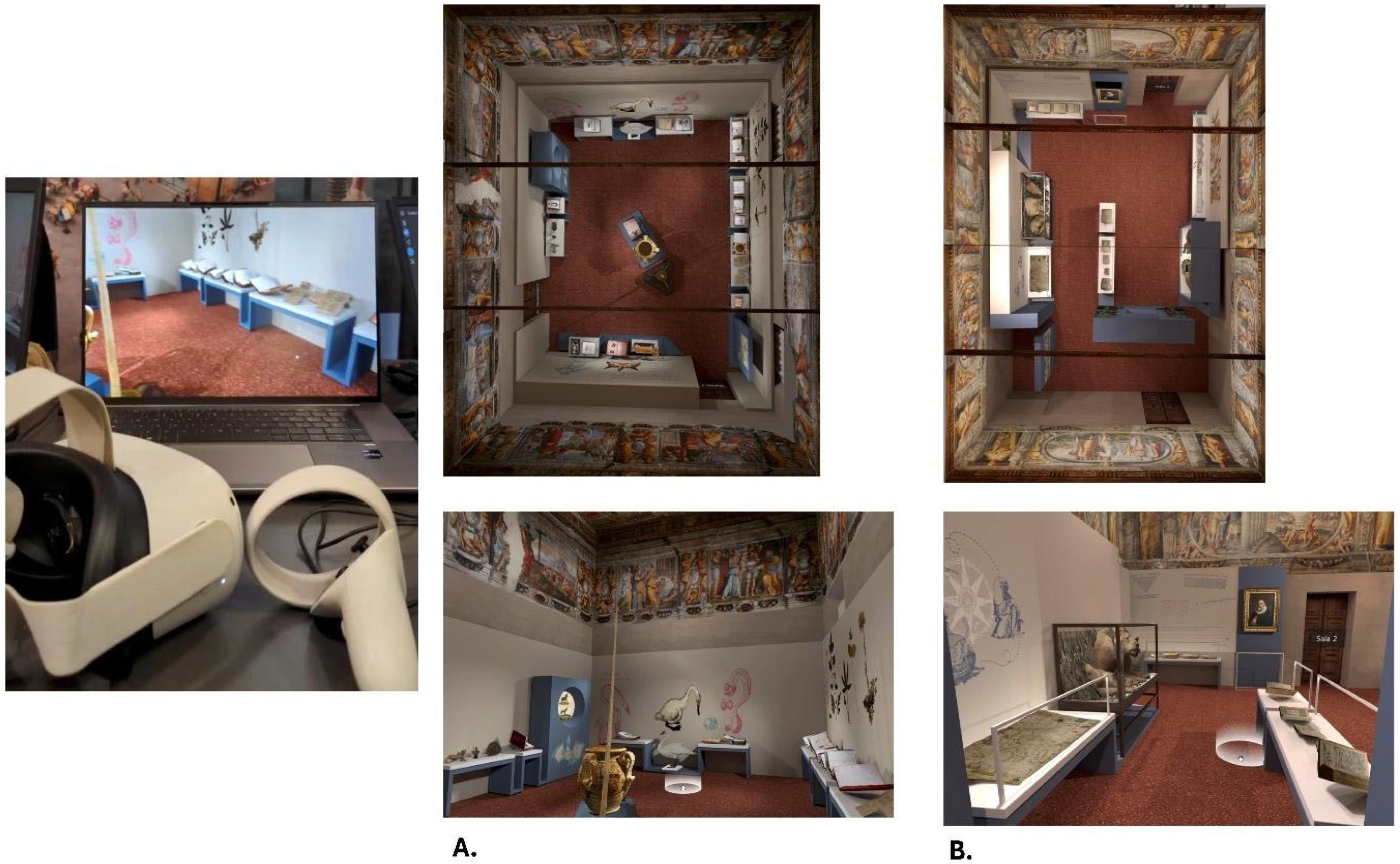
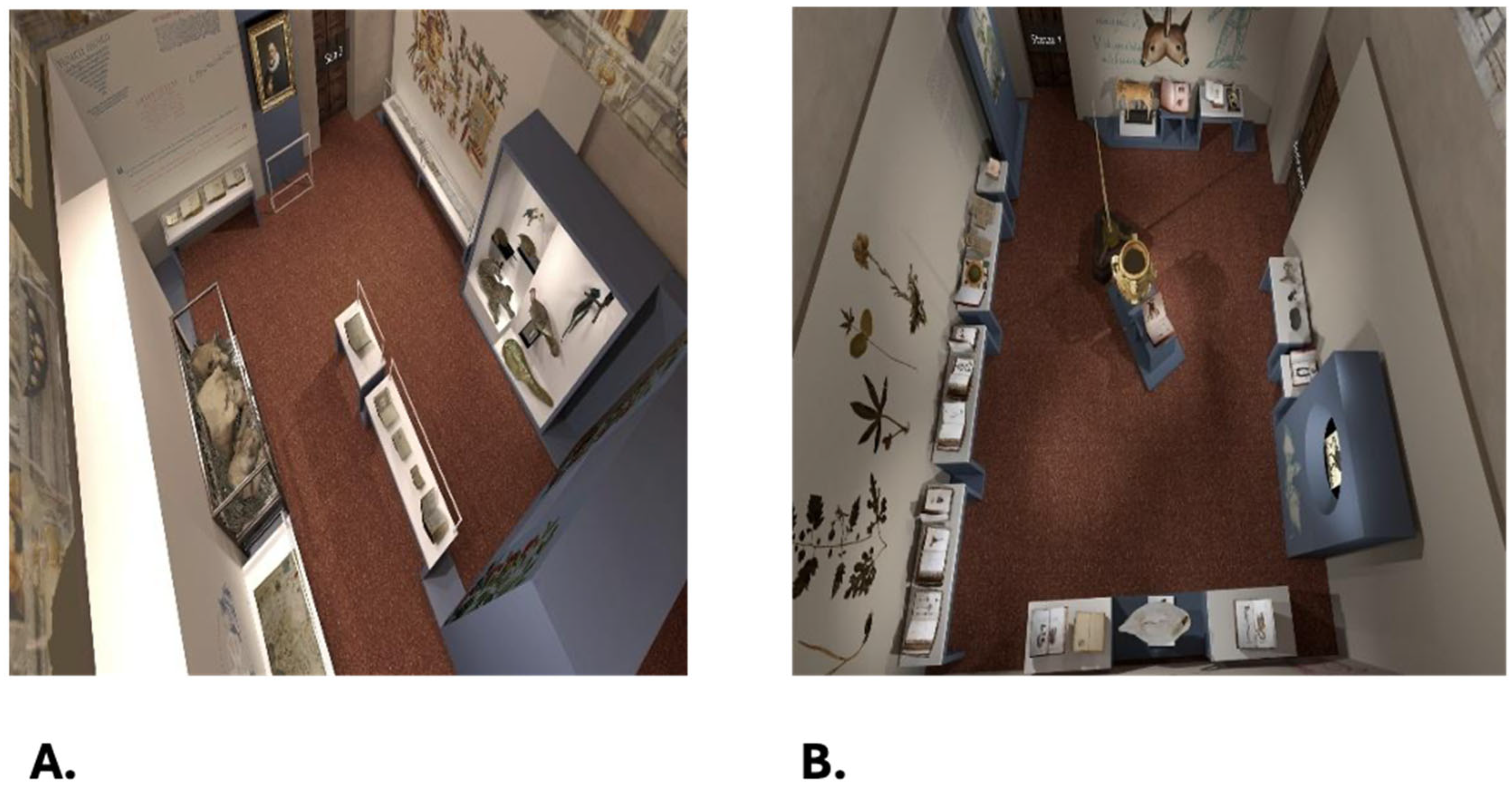
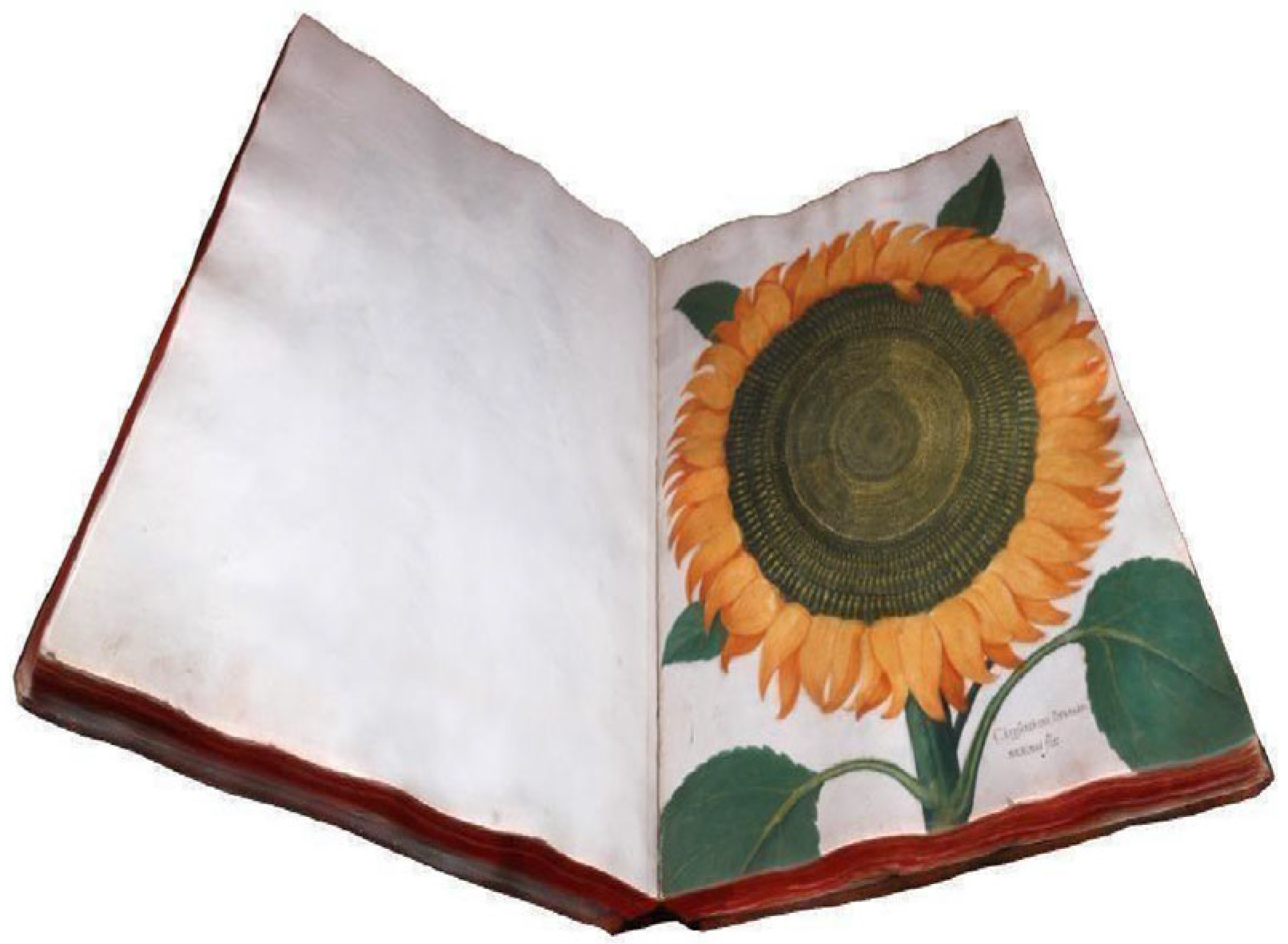
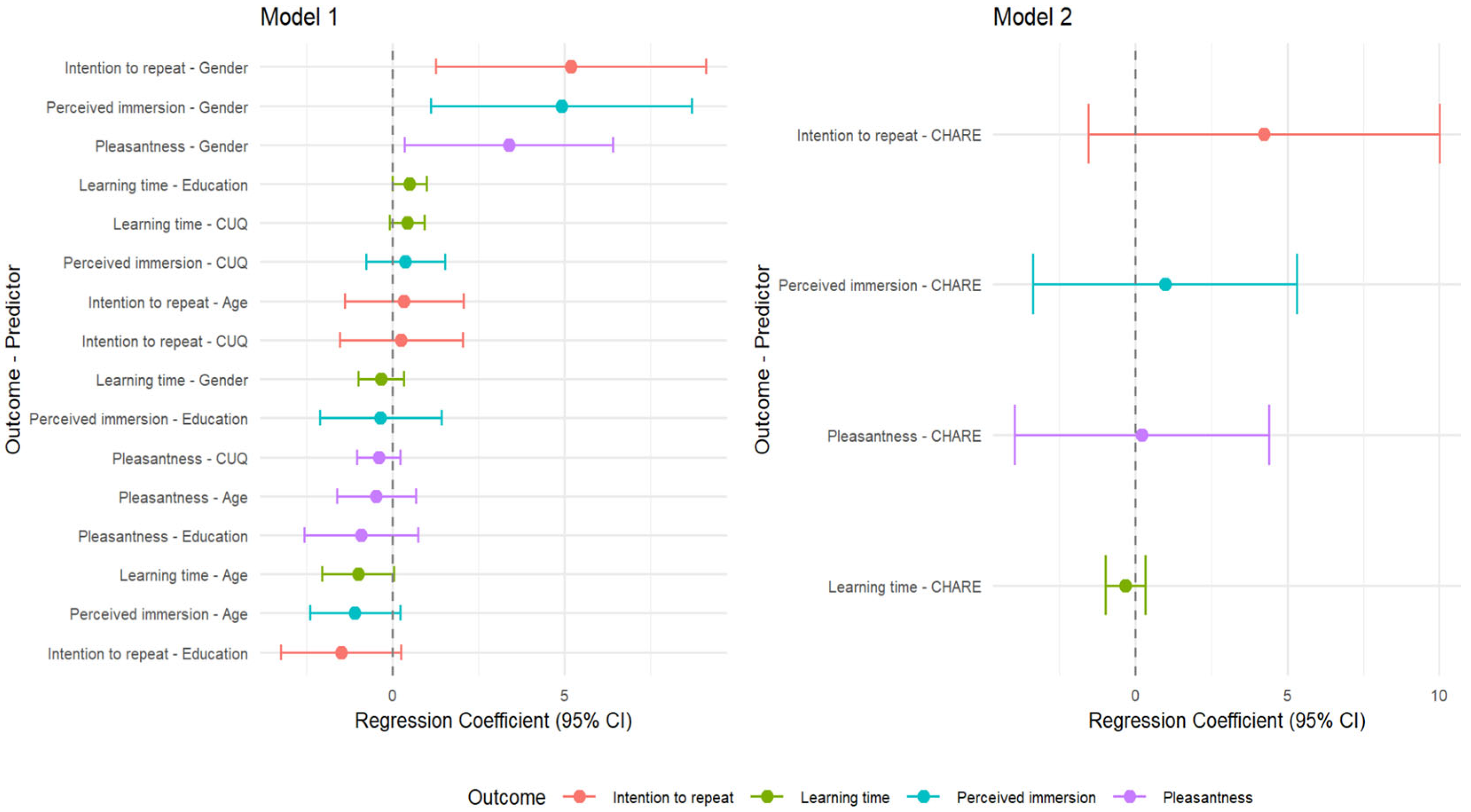
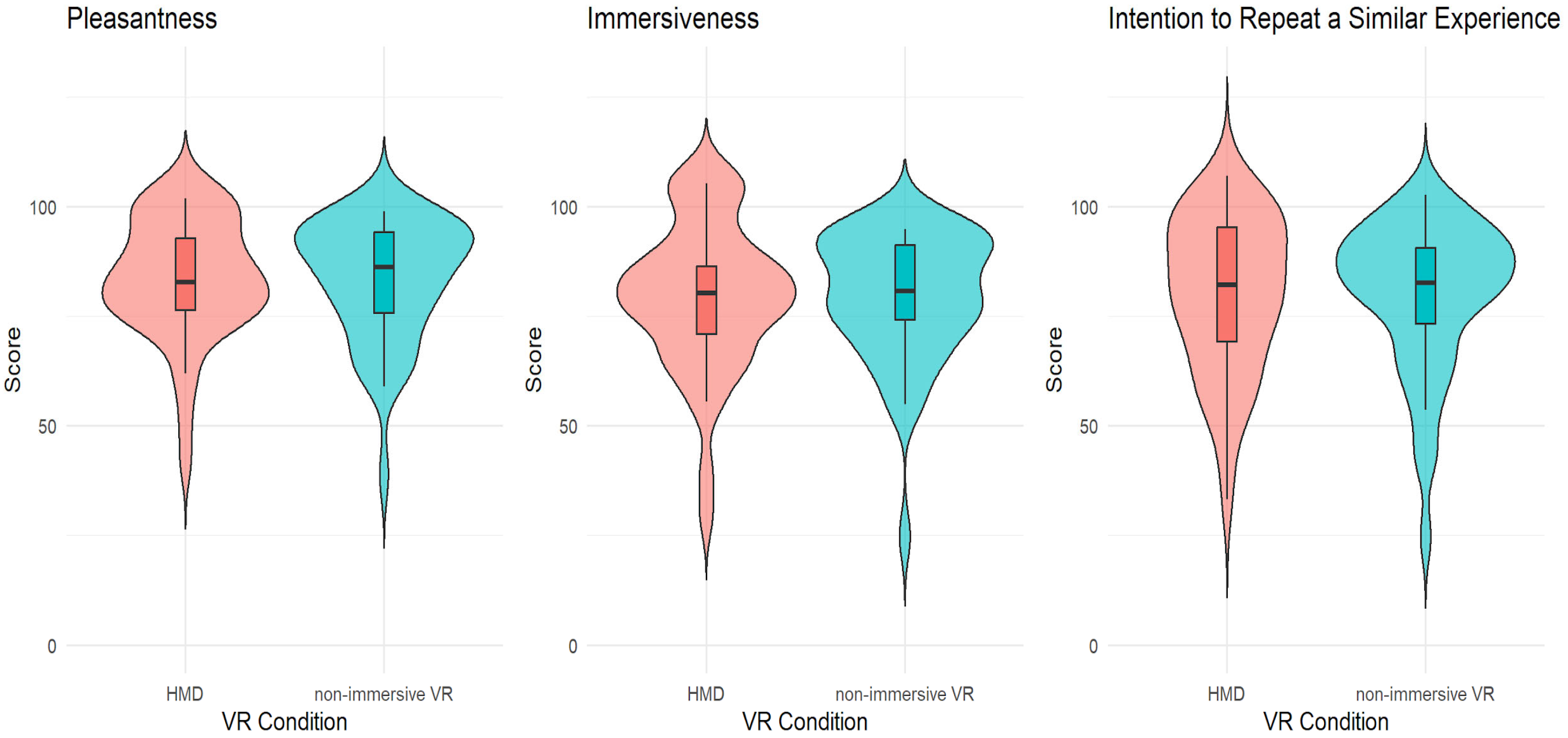
| Research Domain | Principal Findings on HMD-VR vs. Non-Immersive VR |
|---|---|
| Spatial navigation | Mixed results: non-immersive VR outperformed HMD-VR (e.g., [29]) but sometimes no differences were found [30,35] |
| Educational learning | HMD-VR enhances engagement and long-term retention for learning by cultivating longer visual attention and fostering a higher sense of immersion, though students’ short-term retention remains the same across all conditions (e.g., [36,37,38]) |
| Attention | Mixed results: HMD-VR is sometimes better, while other times it is equivalent to the non-immersive VR experience [32,33,34] |
| Age | Gender | Level of Education | CUQ | CHARE | |
|---|---|---|---|---|---|
| Pleasantness | −0.15 | 0.19 | −0.15 | −0.06 | 0.09 |
| Perceived immersion | −0.14 | 0.26 * | −0.07 | 0.02 | 0.14 |
| Intention to repeat similar experiences | −0.00 | 0.26 * | −0.09 | −0.01 | 0.26 * |
| Learning Time | −0.28 ** | −0.12 | −0.18 | −0.08 | −0.16 |
| Path | Effect | SE | BootLLCI | BootULCI |
|---|---|---|---|---|
| VR condition → pleasantness | 7.18 | 2.99 | 1.23 | 13.12 |
| VR condition → perceived immersion | 9.67 | 3.38 | 2.93 | 16.40 |
| pleasantness → learning time | 0.05 | 0.03 | −0.01 | 0.11 |
| perceived immersion → learning time | −0.01 | 0.02 | −0.06 | 0.04 |
| VR condition → pleasantness →learning time (indirect effect) | 0.39 | 0.28 | −0.01 | 1.06 |
| VR condition → perceived immersion → learning time (indirect effect) | −0.11 | 0.26 | −0.68 | 0.37 |
| VR condition → y (direct effect) | 0.23 | 0.69 | −1.15 | 1.60 |
| R2=15 | ||||
| F(8,78) = 1.69 |
Disclaimer/Publisher’s Note: The statements, opinions and data contained in all publications are solely those of the individual author(s) and contributor(s) and not of MDPI and/or the editor(s). MDPI and/or the editor(s) disclaim responsibility for any injury to people or property resulting from any ideas, methods, instructions or products referred to in the content. |
© 2025 by the authors. Licensee MDPI, Basel, Switzerland. This article is an open access article distributed under the terms and conditions of the Creative Commons Attribution (CC BY) license (https://creativecommons.org/licenses/by/4.0/).
Share and Cite
Piccardi, L.; Massidda, M.; Travaglini, L.; Pescarin, S.; Giancola, M.; Palmiero, M.; Deflorian, M.; Apollaro, S.; Lista, R.; Nori, R. Comparing Immersive and Non-Immersive VR: Effects on Spatial Learning and Aesthetic Experience in Museum Settings. Brain Sci. 2025, 15, 852. https://doi.org/10.3390/brainsci15080852
Piccardi L, Massidda M, Travaglini L, Pescarin S, Giancola M, Palmiero M, Deflorian M, Apollaro S, Lista R, Nori R. Comparing Immersive and Non-Immersive VR: Effects on Spatial Learning and Aesthetic Experience in Museum Settings. Brain Sciences. 2025; 15(8):852. https://doi.org/10.3390/brainsci15080852
Chicago/Turabian StylePiccardi, Laura, Marcello Massidda, Laura Travaglini, Sofia Pescarin, Marco Giancola, Massimiliano Palmiero, Matteo Deflorian, Sabrina Apollaro, Roberta Lista, and Raffaella Nori. 2025. "Comparing Immersive and Non-Immersive VR: Effects on Spatial Learning and Aesthetic Experience in Museum Settings" Brain Sciences 15, no. 8: 852. https://doi.org/10.3390/brainsci15080852
APA StylePiccardi, L., Massidda, M., Travaglini, L., Pescarin, S., Giancola, M., Palmiero, M., Deflorian, M., Apollaro, S., Lista, R., & Nori, R. (2025). Comparing Immersive and Non-Immersive VR: Effects on Spatial Learning and Aesthetic Experience in Museum Settings. Brain Sciences, 15(8), 852. https://doi.org/10.3390/brainsci15080852









